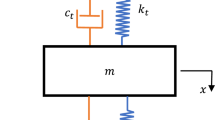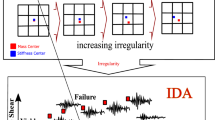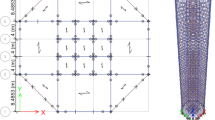Abstract
In recent years, various passive energy dissipation devices have been gradually applied to structural vibration control. Hysteretic dampers with hardening post-yielding stiffness (HDHPSs) could solve the problem of insufficient stiffness after the ordinary friction damper enters into its yield state, and realize multi-level seismic objectives and multi-stage energy dissipation. For hysteretic dampers with hardening post-yielding stiffness, computational formula of its resistance is given in this paper based on Wen-Gap connecting element, and the calculation formula of its equivalent yield strength is derived combining with the energy theory, which is verified by SAP2000 software. A 12-story steel frame with a weak story was strengthened by using HDHPSs and the dynamic performances of three frames are compared by using the connection element method proposed in this paper. The results show that the proposed formula of equivalent yield strength matches well with the numerical simulation results, which could provide a reference for seismic design of structures installed such dampers. The connection element method proposed in this paper is feasible to analyze the dynamic performances of structures with hardening post-yielding stiffness. The frame installed HDHPSs could effectively control the maximum displacement, which could meet the requirement of displacement performance target. This paper has certain reference significance for structural retrofit of existing structures.























Similar content being viewed by others
Data Availability
The data used to support the findings of this study are included within the article.
Change history
25 March 2024
This article has been retracted. Please see the Retraction Notice for more detail: https://doi.org/10.1007/s10878-024-01131-z
References
Anurag S, Tripathi RK, Govardhan B (2020) Comparative performance evaluation of RC frame structures using direct displacement-based design method and force-based design method. Asian J Civil Eng 21(3):381–394
ATC-40, Seismic evaluation and retrofit of concrete buildings, Redwood City, California: SSCSC, 1996
Beheshti-Aval SB, Mahbanouei H, Zareian F (2013) A hybrid friction-yielding damper to equip concentrically braced steel frames. Int J Steel Struct 13(4):577–587
Cardone D (2014) Displacement limits and performance displacement profiles in support of direct displacement-based seismic assessment of bridges. Earthq Eng Struct Dynam 43(8):1239–1263
Christopoulos C, Pampanin S (2004) Towards Performance based design of MDOF structures with explicit consideration of residual deformations. ISET J Earthq Technol 41(1):53–73
Christopoulos C, Filiatrault A, Bertero V (2006) Principles of passive supplemental damping and seismic isolation. IUSS Press, Pavia
Code for seismic design of buildings: GB 50011–2010 [s] Beijing: China State Construction Industry Press, 2016
FEMA 273, (1997) Guidelines for the seismic rehabilitation of buildings, Washington, DC: BSSC, ATC, NEHRP
FEMA 450, (2004) NEHRP Recommended provisions for seismic regulations for new buildings and other structures: Provisions/prepared by the building seis-mic safety council, Washington, D.C: BSSC, NIBS
Godio M, Beyer K (2019) Evaluation of force-based and displacement-based out-of-plane seismic assessment methods for unreinforced masonry walls through refined model simulations. Earthq Eng Struct Dynam 48(4):454–475
Hao L, Zhang R, Jin K (2018) Direct design method based on seismic capacity redundancy for structures with metal yielding dampers. Earthq Eng Struct Dynam 47(2):515–534
Hosseini HB, Moaddab E (2017) Experimental study of a hybrid structural damper for multi-seismic levels. Struct Build 170(10):722–734
Hummel J, Seim W (2019) Displacement-based design approach to evaluate the behaviour factor for multi-storey CLT buildings. Eng Struct 201:1–15
Iemura H, Takahashi Y, Sogabe N (2006) Two-level seismic design method using post-yield stiffness and its application to unbonded bar reinforced concrete piers. Struct Eng Earthq Eng 23(1):109s–116s
Kim J, Seo Y (2004) Seismic design of low-rise steel frames with buckling-restrained braces. Eng Struct 26(5):543–551
Kim J, Choi H (2006) Displacement-based design of supplemental dampers for seismic retrofit of a framed structure. J Struct Eng 132(6):873–883
Kim J, Shin H (2017) Seismic loss assessment of a structure retrofitted with slit-friction hybrid dampers. Eng Struct 130:336–350
Kim J, Choi H, Min KW (2011) Use of rotational friction dampers to enhance seismic and progressive collapse resisting capacity of structures. Struct Design Tall Spec Build 20(4):515–537
Kong C, Kowalsky MJ (2016) Impact of damping scaling factors on direct displacement-based design. Earthq Spectra 32(2):843–859
Kowalsky MJ (2001) RC structural walls designed according to UBC and displacement-based methods. J Struct Eng 127(5):506–516
Lee CH, Kim J, Kim DH, Ryu J, Ju YK (2016) Numerical and experimental analysis of combined behavior of shear-type friction damper and non-uniform strip damper for multi-level seismic protection. Eng Struct 114(may1):75–92
Lee J, Kang H, Kim J (2017) Seismic performance of steel plate slit-friction hybrid dampers. J Constr Steel Res 136:128–139
Lee CH, Ryu J, Kim DH, Ju YK (2018) Improving seismic performance of non-ductile reinforced concrete frames through the combined behavior of friction and metallic dampers. Eng Struct 172:304–320
Li G, Li HN (2007) Seismic design method of energy dissipation and damped structure based on displacement. Eng Mech 24(9):88–94
Li G, Li HN (2013) Experimental study and application of metallic yielding-friction damper. J Earthq Tsunami 07(03):1–13
Li G, Zhu LH, Li HN (2019) Displacement-based seismic design for buildings installed hysteretic dampers with hardening post-yielding stiffness. Adv Struct Eng 22(16):3420–3434
Lin YY, Tsai MH, Hwang JS, Chang KC (2003) Direct displacement-based design for building with passive energy dissipation systems. Eng Struct 25(1):25–37
Lin YY, Chang KC, Chen CY (2008) Direct displacement-based design for seismic retrofit of existing buildings using nonlinear viscous dampers. Bull Earthq Eng 6:535–552
Liu HB, Zhao JX, Qiu C, Zhao SX, Yang SH, He F, Chen ZH (2022) Research progress and prospect of glued laminated timber spatial grid structure. J Hebei Univ Eng 39(04):1–11
Macrae GA, Kimura Y, Roeder C (2004) Effect of column stiffness on braced frame seismic behavior. J Struct Eng 130(3):381–391
Miranda E (1999) Approximate seismic lateral deformation demands in multistory buildings. J Struct Eng 125(4):417–425
Muho EV, Qian J, Beskos DE (2020) A direct displacement-based seismic design method using a MDOF equivalent system: application to R/C framed structures. Bull Earthq Eng 18:18:4157–4188
Nuzzo I, Losanno D, Caterino N (2019) Seismic design and retrofit of frame structures with hysteretic dampers: a simplified displacement-based procedure. Bull Earthq Eng 17(5):2787–2819
O’Reilly GJ, Monteiro R, Nafeh AMB, Sullivan TJ, Calvi GM (2020) Displacement-based framework for simplified seismic loss assessment. J Earthq Eng 24(sup1):1–22
Priestley MJN (2002) Direct displacement-based design of precast/prestressed concrete buildings. PCI J 47(6):66–79
Pu WC, Liang RJ, Liu CQ (2016) Control design of building structure based on displacement and equivalent stiffness. J Struct Archit 37(S1):71–78
Qian JR, Lu W (1999) Seismic design of shear wall based on displacement ductility. J Archit Archit 20(3):42–49
Reggiani MN, Vassiliou MF (2019) Displacement-based analysis and design of rocking structures. Earthq Eng Struct Dynam 48(14):1613–1629
Sahoo DR, Prakash A (2019) Seismic behavior of concentrically braced frames designed using direct displacement-based method. Int J Steel Struct 19(1):96–109
Salem MA, Dicleli M (2016) Systematic development of a new hysteretic damper based on torsional yielding: part I-design and development. Earthq Eng Struct Dynam 45(6):845–867
Shang QX, Zhang XP, Chen X, Wang T (2022) Design method of energy dissipation based on mechanical models of displacement-based dampers. J Archit Archit 43(07):62–71
Structural Engineers Association of California (SEAOC), (1999), Recommended lateral force requirements and commentary, Appendix I, Sacra-mento, Calif
Wei B, Xu Y, Li J (2012) Treatment of P-Δ effects in displacement-based seismic design for SDOF systems. J Bridge Eng 17(3):509–518
Welch DP, Sullivan TJ, Calvi GM (2014) Developing direct displacement-based procedures for simplified loss assessment in performance-based earthquake engineering. J Earthq Eng 18(2):290–322
Wijesundara KK, Rajeev P (2012) Direct displacement-based seismic design of steel concentric braced frame structures. Aust J Struct Eng 13(3):243–257
Yang B, Lu X (2018) Displacement-based seismic design approach for prestressed precast concrete shear walls and its application. J Earthq Eng 22(10):1836–1860
Ye K, Xiao Y, Hu L (2019) A direct displacement-based design procedure for base-isolated building structures with lead rubber bearings (LRBs). Eng Struct 197:1–9
Zhou Y, Deng XS (1999) Performance study of steel yield-friction composite energy dissipation device. Seismic Eng Eng Vibr 19(01):127–131
Zhu LH (2019) Experimental and theoretical study on shock reduction structure of new grille friction damper. Dalian University of Technology, China
Acknowledgements
The authors would like to acknowledge the financial support from Natural Science Foundation of Heibei Province of China (grant No. E2021402074), Science and Technology Project of Hebei Education Department (grant No. QN2023133), the Open Fund of State Key Laboratory of Coastal and Offshore Engineering, Dalian University of Technology (grant No. LP2123), and Science and Technology Research and Development Plan Project of Science and Technology Bureau of Handan (grant No. 21422053283).
Funding
The authors have not disclosed any funding.
Author information
Authors and Affiliations
Contributions
L-HZ was responsible for the supervision, and leadership. X-NM was responsible for the methodology, conceptualization, visualization, software, validation, and data analysis and for writing the manuscript, verification, and investigation.
Corresponding author
Ethics declarations
Conflicts of Interest
The authors declare that there are no conflicts of interest regarding the publication of this paper.
Additional information
Publisher's Note
Springer Nature remains neutral with regard to jurisdictional claims in published maps and institutional affiliations.
This article has been retracted. Please see the retraction notice for more detail: https://doi.org/10.1007/s10878-024-01131-z"
Rights and permissions
Springer Nature or its licensor (e.g. a society or other partner) holds exclusive rights to this article under a publishing agreement with the author(s) or other rightsholder(s); author self-archiving of the accepted manuscript version of this article is solely governed by the terms of such publishing agreement and applicable law.
About this article
Cite this article
Ma, XN., Zhu, LH. RETRACTED ARTICLE: Dynamic analysis of structures installed hysteretic dampers with hardening post-yielding stiffness using connection element method. J Comb Optim 45, 95 (2023). https://doi.org/10.1007/s10878-023-01009-6
Accepted:
Published:
DOI: https://doi.org/10.1007/s10878-023-01009-6




